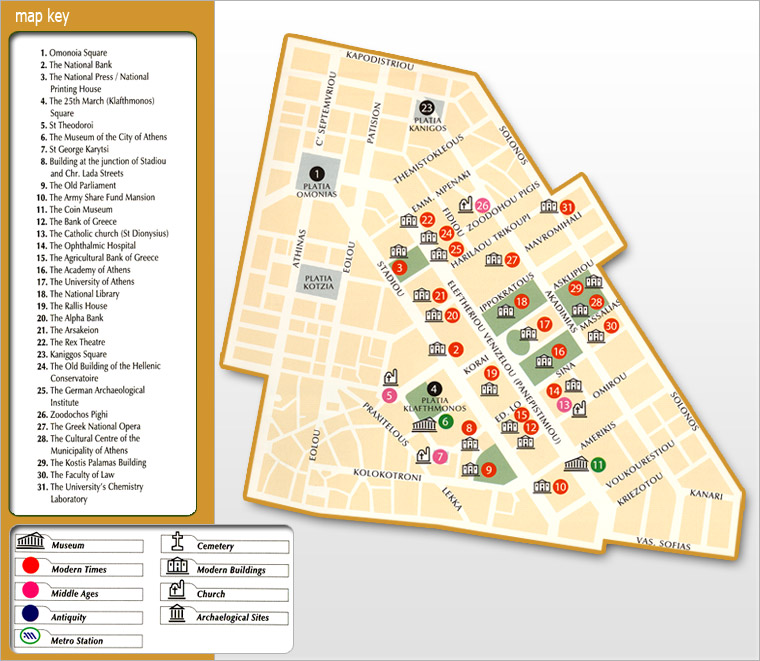Exploring Athens: Walk around the center of Athens and its charms
With the multicultural Omonia Square as a starting point and walking up to Stadiou Street, one reaches the Museum of the City of Athens and the Old Parliament, which today hosts the National Historical Museum. On the opposite side of the street is the Bank of Greece. Its monumental entrance is on El.Venizelou (Panepistimiou) Street. On the other side of the street, three imposing neoclassical buildings, the Academy, the University and the Library, predominate. In the same street, one can also find the Catholic Church of St. Dionysius, the unusual building of the Opthalmic Clinic and the Iliou Melathron, which houses the Numismatic Museum. For a short break, the cafeteria (closed and open-air) of the Cultural Centre of the Municipality of Athens on Akadimias Street is ideal.

9. The Old Parliament
Begun in 1858 and completed in 1871, the neoclassical Old Parliament building was constructed by Francois Boulanger and later, by Panagiotis Kalkos. It housed the Greek Parliament from 1875 to 1935. From 1962, it houses the National Historical Museum. Its collection ranges from 1453 (fall of Constantinople) to the 20th century and the Greek-Italian war of 1940, with special emphasis on the War of Independence.
11. The Numismatic Museum
The Numismatic museum has a collection of 600.000 coins, from antiquity to modern era, which is considered one of the most important worldwide. Since 1984, it has been housed at "Iliou Melathron" (the Palace of Ilion), the residence of the archaeologist Heinrich Schliemann. The building was constructed in the late 19th century by the German architect Ernst Ziller in Renaissance-style and is regarded as a representative example of mature Greek neoclassicism. It also has beautiful frescoes and mosaic floors.
16. The Academy of Athens
The Academy building is a typical example of the 19th neoclassicism. Financed by Sinas, its construction started in 1859 and lasted three decades. It is made from Pentelic marble and follows the Ionian style. The architects Theophilus Hansen and Ernst Ziller were the ones involved. The fresco at the entrance depicts the myth of Prometheus. The statues of Apollo and Athena on top of Ionic columns and the seated statues of Aristotle and Plato were made by Leonidas Drosis.
17. The University of Athens
The university was founded in the early 1820s by Ioannis Kapodistrias. In 1839, started the construction of this striking neoclassic building, designed by the Danish architect Christian Hansen, although Anastasios Theofilas and Lysandros Kaftantzoglou were also involved. The fresco on the facade depicts King Otto fostering a renaissance of arts and sciences. The courtyard is decorated with statues of important personalities from Modern Greek history.
21. Arsakeio Megaron
Designed by Lysandros Kaftantzoglou, this neoclassical building was founded in 1846 in order to house a kindergarten and an institution to train women teachers. Today it hosts the Council of State High Court. The adjacent Arsakeio (Orpheus) arcade, made by glass, hosts bookstores and for this reason, it is called Book Arcade (Stoa Vivliou). Theatro Technis (Art Theatre) is also housed there.
28. The Municipal Cultural Centre of Athens
The Municipal Cultural Centre of Athens was built in 1835. It operated as a municipal and hospital until 1972, when it was refurbished in order to house the Municipal Cultural Centre. It hosts several cultural events and exhibitions. In its garden, one can see statues of famous Greek persons.
29. The Palamas Building
The neoclassical Palamas building belongs to the University of Athens and was built in 1856-57. It is known as the Pink Building, due to its color. In the past, it housed the laboratories of medical and pharmaceutical schools of the University and the city morgue. Today, it houses the Cultural Centre of the University of Athens and the Theatre Museum Library.


